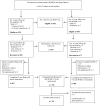Bayley-III motor scale and neurological examination at 2 years do not predict motor skills at 4.5 years
- PMID: 27543144
- PMCID: PMC5209275
- DOI: 10.1111/dmcn.13232
Bayley-III motor scale and neurological examination at 2 years do not predict motor skills at 4.5 years
Abstract
Aim: To determine whether Bayley Scales of Infant and Toddler Development (3rd edition) (Bayley-III) motor scores and neurological examination at 2 years corrected age predict motor difficulties at 4.5 years corrected age.
Method: A prospective cohort study of children born at risk of neonatal hypoglycaemia in Waikato Hospital, Hamilton, New Zealand. Assessment at 2 years was performed using the Bayley-III motor scale and neurological examination, and at 4.5 years using the Movement Assessment Battery for Children (2nd edition) (MABC-2).
Results: Of 333 children, 8 (2%) had Bayley-III motor scores below 85, and 50 (15%) had minor deficits on neurological assessment at 2 years; 89 (27%) scored less than or equal to the 15th centile, and 54 (16%) less than or equal to the 5th centile on MABC-2 at 4.5 years. Motor score, fine and gross motor subtest scores, and neurological assessments at 2 years were poorly predictive of motor difficulties at 4.5 years, explaining 0 to 7% of variance in MABC-2 scores. A Bayley-III motor score below 85 predicted MABC-2 scores less than or equal to the 15th centile with a positive predictive value of 30% and a negative predictive value of 74% (7% sensitivity and 94% specificity).
Interpretation: Bayley-III motor scale and neurological examination at 2 years were poorly predictive of motor difficulties at 4.5 years.
© 2016 Mac Keith Press.
Conflict of interest statement
The authors have stated that they had no interests that might be perceived as posing a conflict or bias.
Figures


Similar articles
-
Does the Bayley-III Motor Scale at 2 years predict motor outcome at 4 years in very preterm children?Dev Med Child Neurol. 2013 May;55(5):448-52. doi: 10.1111/dmcn.12049. Epub 2012 Dec 6. Dev Med Child Neurol. 2013. PMID: 23216518
-
In extremely preterm infants, do the Movement Assessment of Infants and the Alberta Infant Motor Scale predict 18-month outcomes using the Bayley-III?Early Hum Dev. 2016 Mar;94:13-7. doi: 10.1016/j.earlhumdev.2016.01.012. Epub 2016 Feb 10. Early Hum Dev. 2016. PMID: 26874215
-
Predictive value of Bayley-III Motor Index for later motor difficulties in children born extremely preterm.Acta Paediatr. 2023 Apr;112(4):742-752. doi: 10.1111/apa.16694. Epub 2023 Feb 20. Acta Paediatr. 2023. PMID: 36723223
-
Psychometric properties of gross motor assessment tools for children: a systematic review.BMJ Open. 2018 Oct 27;8(10):e021734. doi: 10.1136/bmjopen-2018-021734. BMJ Open. 2018. PMID: 30368446 Free PMC article.
-
Assessing developmental delay in early childhood - concerns with the Bayley-III scales.Clin Neuropsychol. 2017 Feb;31(2):371-381. doi: 10.1080/13854046.2016.1216518. Epub 2016 Aug 12. Clin Neuropsychol. 2017. PMID: 27687612 Review.
Cited by
-
Prophylactic Oral Dextrose Gel and Neurosensory Impairment at 2-Year Follow-up of Participants in the hPOD Randomized Trial.JAMA. 2022 Mar 22;327(12):1149-1157. doi: 10.1001/jama.2022.2363. JAMA. 2022. PMID: 35315885 Free PMC article. Clinical Trial.
-
Prenatal and childhood exposure to phthalates and motor skills at age 11 years.Environ Res. 2019 Apr;171:416-427. doi: 10.1016/j.envres.2019.01.046. Epub 2019 Jan 29. Environ Res. 2019. PMID: 30731329 Free PMC article.
-
Neurocognitive Outcomes at Age 2 Years After Neonatal Hypoglycemia in a Cohort of Participants From the hPOD Randomized Trial.JAMA Netw Open. 2022 Oct 3;5(10):e2235989. doi: 10.1001/jamanetworkopen.2022.35989. JAMA Netw Open. 2022. PMID: 36219444 Free PMC article. Clinical Trial.
-
Association of the Onset of Self-Feeding With Subsequent Suspected Developmental Coordination Disorder: A Prospective Cohort Study in China.Front Psychiatry. 2022 May 6;13:818771. doi: 10.3389/fpsyt.2022.818771. eCollection 2022. Front Psychiatry. 2022. PMID: 35599757 Free PMC article.
-
Cross-cultural validity and reliability of the BRIEF-P at age 2 and 4.5 years in children born at risk of neonatal hypoglycemia.Child Neuropsychol. 2023 Feb;29(2):340-356. doi: 10.1080/09297049.2022.2093340. Epub 2022 Jul 4. Child Neuropsychol. 2023. PMID: 35786313 Free PMC article.
References
-
- Bart O, Jarus T, Erez Y, et al. How do young children with DCD participate and enjoy daily activities? Res Dev Disabil. 2011;32:1317–22. - PubMed
-
- Barnett LM, van Beurden E, Morgan PJ, et al. Childhood motor skill proficiency as a predictor of adolescent physical activity. J Adolesc Health. 2009;44:252–9. - PubMed
-
- Boreham C, Riddoch C. The physical activity, fitness and health of children. J Sports Sci. 2001;19:915–29. - PubMed
-
- Goyen T, Lui K. Developmental coordination disorder in “apparently normal” school children born extremely preterm. Arch Dis Child. 2009;94:298–302. - PubMed
-
- Bolaños L, Matute E, Ramírez-Dueñas MDL, et al. Neuropsychological impairment in school-aged children born to mothers with gestational diabetes. J Child Neurol. 2015;30:1616–24. - PubMed
MeSH terms
Grants and funding
LinkOut - more resources
Full Text Sources
Other Literature Sources
Medical

